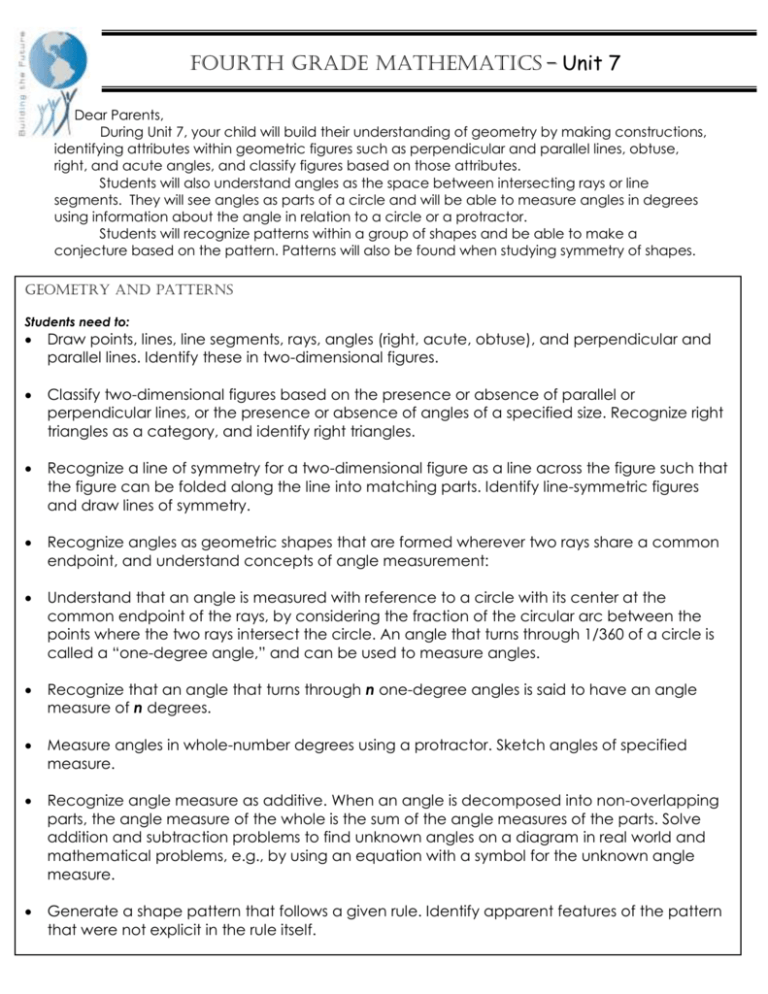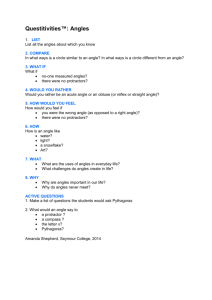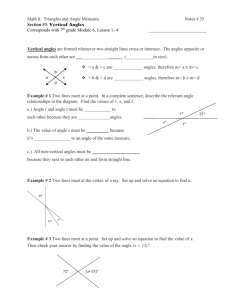Parent Letter
advertisement

Fourth Grade Mathematics – Unit 7 Dear Parents, During Unit 7, your child will build their understanding of geometry by making constructions, identifying attributes within geometric figures such as perpendicular and parallel lines, obtuse, right, and acute angles, and classify figures based on those attributes. Students will also understand angles as the space between intersecting rays or line segments. They will see angles as parts of a circle and will be able to measure angles in degrees using information about the angle in relation to a circle or a protractor. Students will recognize patterns within a group of shapes and be able to make a conjecture based on the pattern. Patterns will also be found when studying symmetry of shapes. Geometry and patterns Students need to: Draw points, lines, line segments, rays, angles (right, acute, obtuse), and perpendicular and parallel lines. Identify these in two-dimensional figures. Classify two-dimensional figures based on the presence or absence of parallel or perpendicular lines, or the presence or absence of angles of a specified size. Recognize right triangles as a category, and identify right triangles. Recognize a line of symmetry for a two-dimensional figure as a line across the figure such that the figure can be folded along the line into matching parts. Identify line-symmetric figures and draw lines of symmetry. Recognize angles as geometric shapes that are formed wherever two rays share a common endpoint, and understand concepts of angle measurement: Understand that an angle is measured with reference to a circle with its center at the common endpoint of the rays, by considering the fraction of the circular arc between the points where the two rays intersect the circle. An angle that turns through 1/360 of a circle is called a “one-degree angle,” and can be used to measure angles. Recognize that an angle that turns through n one-degree angles is said to have an angle measure of n degrees. Measure angles in whole-number degrees using a protractor. Sketch angles of specified measure. Recognize angle measure as additive. When an angle is decomposed into non-overlapping parts, the angle measure of the whole is the sum of the angle measures of the parts. Solve addition and subtraction problems to find unknown angles on a diagram in real world and mathematical problems, e.g., by using an equation with a symbol for the unknown angle measure. Generate a shape pattern that follows a given rule. Identify apparent features of the pattern that were not explicit in the rule itself. Key Vocabulary acute angle/triangle angle circle decompose degree endpoint figure geometric shape intersect line line segment parallel perpendicular point protractor obtuse angle/triangle one-degree angle ray right angle/triangle straight unknown vertex equilateral triangle isosceles triangle scalene triangle line of symmetry Background information and examples for Parents Draw points, lines, line segments, rays, angles (right, acute, obtuse), and perpendicular and parallel lines. Identify these in two-dimensional figures: http://learnzillion.com/lessons/2313-draw-parallel-and-perpendicular-lines http://learnzillion.com/lessons/2521-identify-points-lines-rays-and-angles-in-atwodimensional-figure http://learnzillion.com/lessons/2346-draw-points-lines-and-line-segments http://learnzillion.com/lessons/3918-identify-parallel-intersecting-andperpendicular-lines Classify two-dimensional figures based on the presence or absence of parallel or perpendicular lines, or the presence or absence of angles of a specified size. Recognize right triangles as a category, and identify right triangles: http://learnzillion.com/lessons/2988-classify-parallelograms-by-examining-theirangles-and-sides http://learnzillion.com/lessons/3069-classify-right-triangles http://learnzillion.com/lessons/2936-classify-various-quadrilaterals-by-describingtheir-properties http://learnzillion.com/lessons/2879-classify-twodimensional-figures-by-examiningtheir-properties Recognize a line of symmetry for a two-dimensional figure as a line across the figure such that the figure can be folded along the line into matching parts. Identify line-symmetric figures and draw lines of symmetry: http://learnzillion.com/lessons/3215-identify-line-symmetry-in-a-geometric-figure Ways Parents Can Help Help your child to identify examples of angles in real life objects. Use a protractor to measure the angles. See the directions/illustrati ons on the next page for how to use straws and pipe cleaners to create geometric shapes. Recognize angles as geometric shapes that are formed wherever two rays share a common endpoint, and understand concepts of angle measurement: http://learnzillion.com/lessons/3637-identify-angles-using-angle-characteristics An angle is measured with reference to a circle with its center at the common endpoint of the rays, by considering the fraction of the circular arc between the points where the two rays intersect the circle. An angle that turns through 1/360 of a circle is called a “onedegree angle,” and can be used to measure angles. An angle that turns through n one-degree angles is said to have an angle measure of n degrees: http://learnzillion.com/lessons/3638-measure-an-angle-using-fractions-of-a-circle Measure angles in whole-number degrees using a protractor. Sketch angles of specified measure: http://learnzillion.com/lessons/2973-measure-angles-to-the-nearest-degree-withprotractors Recognize angle measure as additive: http://learnzillion.com/lessons/3253-understand-that-angle-measure-is-additiveby-decomposing Generate a shape pattern that follows a given rule. Identify apparent features of the pattern that were not explicit in the rule itself: http://learnzillion.com/lessons/795-using-a-table-to-find-the-rule-for-a-geometrictriangle-pattern How To Use Straws and Pipe Cleaners to Make Geometric Shapes Use straws and pipe cleaners to make geometric shapes. The instructions below show how to build an equilateral triangle. Use the same linking method to construct a variety of regular polygons. For some shapes you will need straws of different lengths within the same shape.








